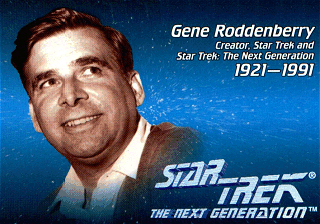
|
What I principally take credit for is, I surrounded myself with a group of very talented and creative individuals, from the art director, to the costume, and wardrobe designers, and to the actors who took my "skeletons" of Mr. Spock and Kirk and really put the "flesh" on the skeleton and made 'em work.......... Television is sort of the exception to the rule that a committee never created anything. The committee in this case does need leadership, but it is a group effort. ------------Gene Roddenberry |
|
The story of Star Trek begins August 19, 1921, in El Paso, Texas, where Eugene W. Roddenberry was born. A sickly but imaginative child, Roddenberry read voraciously - Edger Rice Burroughs's Mars novels, science fiction in Astounding Stories magazine. As he grew older, both his health and his imagination continued to improve. Bitten earlier by the writing bug, he served as a B-17 bomber pilot during World War II, using his off-duty moments to pen aviation magazine articles and poetry, some of which he sold to The New York Times. After the war, Roddenberry became an international airline pilot for Pan American World Airways, but the urge to write never left him. He continued to produce magazine articles and dreamt of going to Hollywood to launch a career as a writer. In 1949, he gave in to his dream: he quit his pilot's job and moved to Los Angeles, hoping to write fot the new medium if television. In the meantime, he paid the rent by joining the Los Angeles Police Department. Even there his talent for stringing words together didn't go unnoticed, and he began writing speeches for then Chief of Police William Parker. Eventually, Roddenberry procured an agent and began selling scripts to TV series. Soon after, when he realized he was earning far more as a script writer than as a cop, he turned in his badge and began writing full time. A number of script sales followed---to "Dragnet", Playhouse 90", "Naked City", and "Doctor Kildare", among others. In due time, he landed a job as a story editor on "Have Gun Will Travel"; his script for that series' episode "Helen of Abajnian" won him the prestigious Writers' Guild Award. In 1959, he turned to producing, for as he said, "it became apparent to me that if you want the film to reflect accurately what you felt when you wrote the script, then you have to produce it, too." His first few pilots failed to sell (one of them, "333 Montgomery", starred DeForest Kelly). Finally, he soldthe Marine Corps drama "The Lieutenant", which featured Gary Lockwood and Robert Vaughn. (Actors Leonard Nimoy, Nichelle Nichols, Walter Koenig, Grace Lee Whitney, and Majel Barrett all guest-starred on the series.) "The Lieutenant" only lasted one season, amd it was gearing down, Roddenberry's thoughts turned to his next series---and the future. At that time, he was greatly influenced by a recent nonfiction book, Arthur C Clarke's Profiles of the future, which discussed "space drive", "warped space", and "instantaneous transportation". Inspired, Roddenberry decided that his next series would be a science-fiction show. "Now", he said, "perhaps I'd be able to talk about love, war, nature, God, sex ... and maybe the TV censors would let it pass because it all seemed so make-believe". Thus Star Trek was born. Roddenberry's original concept was that of a "Wagon Train to the Stars", and included the Starship Yorktown plus significantly different characters from the ones we know today: ship's captain Robert April, the logical female second-in-command Number One, navigator Jose Tyler, captain's yeoman J.M. Colt, and elderly Dr. Philip Boyce. And as for Spock.. According to Samuel A. Peeples, writer of the episode, " Where No Man Has Gone Before ", "Spock was [originally] a red-skinned creature with fiery ears, who had a plate in the middle of his stomach. He didn't eat or drink, but he fed upon any form of energy that struck this plate in his stomach. I told Gene that I thought this very effectively destroyed him as an interesting character because he was no longer human and that he should be at least half-human and have the problems of both sides." Unfortunately, MGM, who had backed "The Lieutenant", didn't think science fiction would appeal to 1960's viewers. Roddenberry shopped his series concept to several studios, but all rejected it as too risky and expensive-----all except Desilu, which was actively seeking new projects and signed Roddenberry to a three-year deal. With Desilu's backing, Roddenberry started pitching his new show to the networks. He began with CBS executives, who, after pumping him for information about his new science-fiction idea, informed him they already had a more "adult" science-fiction series in the works, named "Lost in Space". But NBC was interested, and commissioned a pilot. Roddenberry developed three story ideas; of them, NBC chose "The Cage", and so Roddenberry set to work on the pilot script. In September 1964, the network approved the script, and the first STAR TREK pilot was under way. The captain's name had been changed from Robert April to Christopher Pike (and the ship's name from the Yorktown to the Enterprise), but otherwise the cast of characters adhered to the original format. Roddenberry approached Lloyd Bridges of "Sea Hunt" fame to play the lead, but when Bridges turned him down, Jeffrey Hunter was chosen to play Captain Pike. Veteran character actor John Hoyt was cast as Dr. Phillip Boyce, and Majel Barret as the frosty, logical Number One. |
|